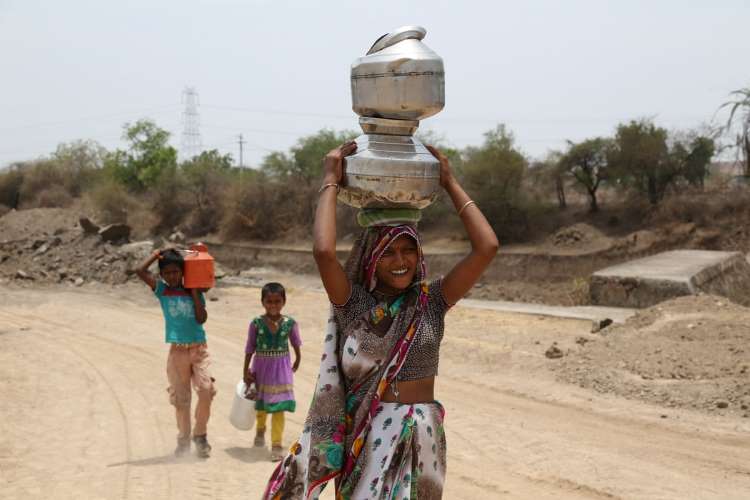
Addressing inequality has been one of the major objectives of the plans and schemes launched by successive governments since independence, All such plans met with limited success. The wide-ranging economic reforms initiated in 1991 seem to have further aggravated the regional imbalance, with richer regions forging ahead of the poorer ones. The stark inequalities across different regions can be attributed to natural, social and historical reasons.
The genesis of regional imbalances in development can be traced to the colonial period since the British government provided necessary infrastructure and facilities selectively to gain control over India. Big centers like Calcutta, Bombay, and Madras were developed as major trading centers and port cities, resulting in states like Bengal and Maharashtra cornering a large number of the industries
and bigger share of economic prosperity.
States such as Bihar, Madhya Pradesh, and Assam were treated as sources of natural resources and labour. Even after 75 years of planned development, the gap remains and has widened in many areas. Despite national per capita income increasing from around Rs 6,000 in 1990 to Rs 1, 07,670 at present, the country slipped to a dismal global rank of 131 in the HDI index in 2019 from 114 in 1991, indicative of the poorer living standards of a larger section of the population.
READ I Multidimensional Poverty: Niti Aayog report points to need for course correction
Inequality is a global phenomenon. The World Inequality Report 2022 brought out by Paris-based World Inequality Lab has admitted that income and wealth inequalities have been on the rise globally since the 1980s and the weight of private wealth has increased at the expense of public wealth due to deregulation, privatisation, and increasing government debt across countries.
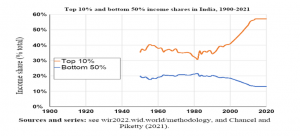
The report which was rejected by the Indian government places India among the most unequal countries with a ranking of 69 out of 169 countries. The report says that in India, the top 1% and 10% hold 22% and 57% of the total national income respectively, and the share of the bottom 50% has gone down to 13.1%. Incidentally, at the global level too, it is not much different as per the report since the top 10% holds 52% of the total income.
Inequality within India
The disparity is measured by different indicators like the proportion of the population living below the poverty line, percentage of urban population, and the percentage of population engaged in agriculture. The per capita income is the most commonly employed indicator of income distribution. In India, the per capita income had seen steady growth since independence. It reached $100 in 1963 and picked up growth in the 1980s. However, the pace of growth picked up after crossing the figure of $500 in 2003 to reach $1901 in 2020 (Source: World Bank data).
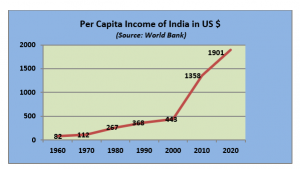
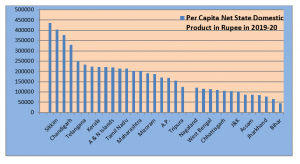
The benefits of growth remained confined to some regions, particularly, in the west and south. Even if we overlook the data of smaller states like Goa (at the top) , Delhi, Sikkim, Chandigarh, or Puduchery, the per capita income of advanced states like Haryana, Telangana, Karnataka, Tamil Nadu, Gujarat, Kerala, and Maharashtra shows a huge gap compared to that of laggard states such as Bihar, UP, Jharkhand, Odisha, MP, and Chhattisgarh.
The average per capita income of these poor states having 41% of the country’s total estimated population comes to $1,178, much less than the average per capita income of $3,002 of the advanced states representing 33% of the population. (Data Source: RBI Publications) The incidence of disparity is not restricted among states only, the unevenness in income even within states is glaring. Bihar had the lowest per capita income in the country at Rs 50,745 in 2020 against the national average of Rs 1,35,000. Bihar’s capital city Patna had a per capita income of Rs 1,12,280 in 2017–18, the highest in the state and somewhat closer to the national average.
The per capita income of the most prosperous second and third cities in Bihar namely Begusarai and Munger districts were at Rs 45,540 and Rs 37,000 respectively, which were less than half of Patna’s (Source: Bihar Economic Survey for 2020-21). The extent of economic imbalance in Bihar can be understood from the per capita income of the lowest placed district of Sheohar which is just one-sixth of Patna’s.
Multidimensional poverty index
The multidimensional poverty index (MPI) is being adopted globally in place of the conventional poverty assessment method based on incomes. The MPI takes into consideration various deprivations experienced by people in their daily lives such as poor health, deficient education, and a low standard of living. The baseline report by NITI Aayog on the national MPI was published in September 2021 which ranked states on multidimensional poverty, indicating the percentage of the population living below the poverty line, and the data below exemplify the gap between rich and poor states in terms of broader parameters.
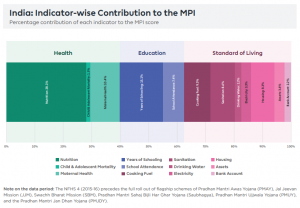
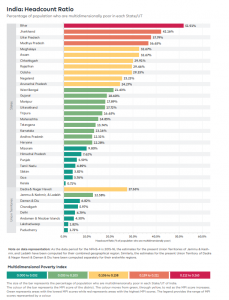

The MPI report reconfirms the extent of the economic divide between states. It also identifies the areas of glaring deficiencies in health, education, and a set of parameters covering the standard of living in the poor states which makes it easier for the government to devise focused schemes. While the report confirms the success achieved in poverty reduction efforts since 2004, it also reminds us that a large service sector-driven growth will remain concentrated in urban centers and has limited effect on poverty reduction in rural areas.
Two large states at the bottom of the ladder — UP and Bihar — have almost the same percentage of population below the poverty line despite an increase in per capita income since 2004. The other three laggard states namely Rajasthan, MP, and Odisha made some progress in poverty reduction efforts during 2004-2010. However, the pace of positive growth was not maintained in the next decade. On the other hand, advanced states like Maharashtra, Gujarat, Karnataka, Tamil Nadu, and Telangana continued to register an impressive rate of success in removing people from the clutches of extreme poverty.
Foreign investors inclined towards developed states
India has emerged as a preferred destination for foreign direct investment (FDI) with impressive inflows. However, foreign investors select such locations for investment that offer better availability of skilled manpower, connectivity, infrastructure, and overall ease of doing business. The advanced states had a giant share in the total FDI received in the country as depicted in the graphic below. While the overall data speaks well in favour of the investment climate in India; the trend is not at all supportive of bridging the development-related gaps in between the states.
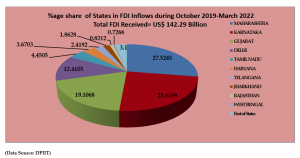
Looking at the data from states, the following features are found to be distinguishing between the forward and laggard states.
- Almost all the states in the top 10 of the list in the higher per capita income bracket have a literacy rate higher than the national average of 77.7%, and those at the bottom of the ladder lag behind the national average by 5-15%. Nevertheless, a higher literacy rate does not mean the existence of a quality education and training ecosystem.
- The share of agriculture in states’ income (GSDP) has seen a substantial fall across states since 2004-05. However, the decrease is higher in forward states.
- The services sector in poor states has gained at the expense of agriculture since 2004, a phenomenon which is not shared by the states with higher per capita income. In particular, states like Maharashtra, Tamil Nadu, and Gujarat have performed impressively in raising the share of manufacturing in their income and the share of the services have decreased to some extent during the period. A higher share of manufacturing in GSDP is considered a positive sign for employment opportunities as well as personal incomes.
- The top four states Maharashtra, Gujarat, Karnataka, and Tamil Nadu have a combined share of 46% of the total number of persons engaged in Industry in India.
- Two states Maharashtra and Karnataka together attracted 50% of the total FDI received in India during the last 30 months beginning October 2019. On the other hand, Bihar, UP, Rajasthan, MP, and Odisha could only manage to receive a meager 0.11%, 0.61%, 0.82%, 0.34%, and 0.09% respectively of total inflows.
Strategies to tackle disparities
The states at the bottom of the ladder need a thorough restructuring of their development plan and strategy to bridge the widening development gap with the rest of India. The growing gap is causing migration and social problems. The implementation of the development plan would need a location-specific strategy supported by an improved level of governance along with creating appropriate social and physical infrastructure.
Agriculture sector
More than half of India’s poor live in Bihar, Madhya Pradesh, Jharkhand, Odisha, and Uttar Pradesh which are agricultural states with small landholders and casual workers. As per the ‘Situation Assessment of Agricultural Households and Land and Holdings of Households in Rural India 2019’, the average monthly income from different sources per agricultural household from July 2018 to June 2019 was only ₹10,218. It was the result of a sharp deceleration in the growth in income realised from crop cultivation between 2012-13 and 2018-19.
The fragmented land holdings are a big barrier to the adoption of mechanisation and that is one reason for low level of farm mechanization. In Bihar and UP, the average size of land holdings is less than 1 ha. In Punjab or Haryana, the average size of land holdings is higher and these states have seen high penetration of farm machinery in agricultural operations. A reduction in labour occupancy in agriculture is directly related to an increase in the income out of cultivation in a given land area.
The overall labour productivity in India is not only low compared with other emerging economies; it also shows large variations even within states. Several studies have established strong and direct linkages between agricultural productivity and poverty in rural areas. Moreover, in recent years, the labour cost has gone up due to a decline in labour availability for agriculture. The MGNREGA, an employment generating scheme, has also caused an increase in labour charges, further reducing the income from cultivation.
Regular increase in the cost of inputs like fertilizers and water for irrigation also contributes to the higher cost of cultivation. All these issues need to be addressed for making agriculture reasonably profitable. With wide variations in agro-climatic conditions across the country, there cannot be a single strategy for increasing the productivity in farming across the country. Any strategy for enhancing the level of productivity has to be location-specific even within a state, as there are wide variation in soil conditions and climate.
Given the many issues faced in corporatisation of farming and other land reform measures, a strategy based on scientific analysis of soil for raising suitable crops with modern methods of irrigation, fertilizer, and better seeds could be successful. In states like Assam, Bihar, and UP, flood control should also be given priority to prevent the regular loss of crops and property. And finally, market reforms have the potential to lift the economic viability of farming as it helps the farmer in getting the returns of their labour.
Employment in non-farm activities
Any strategy for reduction of labour occupied in agriculture to increase productivity necessitates generating employment in non-farm activities. It is established that non-farm sector employment in rural areas has a significant impact on the poverty level. However, success in generating non-farm employment in rural or semi-urban areas will require strong intervention by the state as it depends on the establishment and growth of sectors like education, healthcare, connectivity, communication, and other infrastructural development.
The non-farm sectors generally require improved skills for employment which is possible through better education and training. Unfortunately, the growth of skilled manpower has not kept pace with the increased demand both in terms of numbers and emerging technological needs. The conventional curricula in the colleges and universities in states like UP, Bihar, and MP do not offer youths adequate skills in such new areas showing the lack of synchronicity between the education system and market needs. Even if the curricula are prepared based on the needs of modern businesses, the quality of teachers and trainers is often a major issue.
The Pradhan Mantri Kaushal Vikas Yojana (PMKVY) was introduced as India’s largest skill development scheme to enable Indian youth take up industry-relevant skill training that will help them secure better livelihoods. Several impact assessment reports on the PMKVY have assessed the success as moderate only due to shortcomings in the skill development curricula and their implementation.
To overcome such shortcomings, the PMKVY needs more improvements in the form of an industry-specific training curriculum to bridge the skill mismatch, upgradation of training infrastructure, training for trainers, and more participation from private sector. The training requirements should be developed as per the needs of an individual district or region and need to be aligned with the concept of the One District One Product (ODOP) scheme.
Leveraging Indian diaspora
When foreign investors establish a venture in India, it helps in generating employment and getting cutting-edge technology. It also helps in better infrastructure creation for healthcare, transportation, etc. All this is good for the economy and India will benefit from them; however, the preferences of foreign investors are often based on commercial reasons, some of which are not conducive to the development of less developed regions.
Apart from their choices for already developed locations discussed earlier, a large component of foreign investment received has gone to the services sector, in Brownfield investment or acquisition of an existing business, and without real transfer of knowhow. The benefits in terms of the development of backward areas, creation of employment, and absorption of technology have been limited.
India needs to leverage its invaluable resource of 18 million overseas Indians which largely remains untapped. Fortunately, this group continues to maintain strong connection to the homeland. It is time that the Indian government leveraged this strong bond for the nation to create a win-win partnership with Indians settled abroad having both capital and knowledge to target investment in specific sectors to derive the maximum benefits. The government will have a major role in terms of creating a platform for interactions, offering ease in business processes and fiscal incentives for attracting investments in areas generally overlooked.
Innovative market mechanism
Small farmers who form the bulk of the agri-food supply chain are faced with challenges with the domestic markets undergoing rapid modernisation, besides facing other existing challenges of weak market linkages and inefficient supply chains resulting in high levels of food wastage.
The huge retail industry is expected to grow in size with the expanding size of the middle class. A modern expanding market and its supply chain have the potential to offer increased economic opportunities for all players in the agrifood and processed food chain including the small producers. High transaction costs and additional risks are generally associated with procurement from fragmented land owners/small-scale farmers having low production volumes, and less access to technology and finance. It will require innovative business models that will incorporate the specific advantages which a small landholder possesses.
It is for the stakeholders to ensure that the benefits of technology reach the bottom of the pyramid, making it more inclusive. The Open Network for Digital Commerce (ONDC) proposed by the DPIIT is a good initiative in this direction and is stated to be working to activate e-commerce in the agriculture domain in partnership with the National Bank for Agriculture and Rural Development (NABARD). Hopefully, its focus on establishing market linkages for the small farmers will help them participate in the market along with the large players.
Krishna Kumar Sinha is an industrial policy and FDI expert based in New Delhi. His last assignment was as an industrial adviser in the department of industrial policy and promotion, DIPP, currently known as DPIIT, under the ministry of commerce and industry of the government of India.

